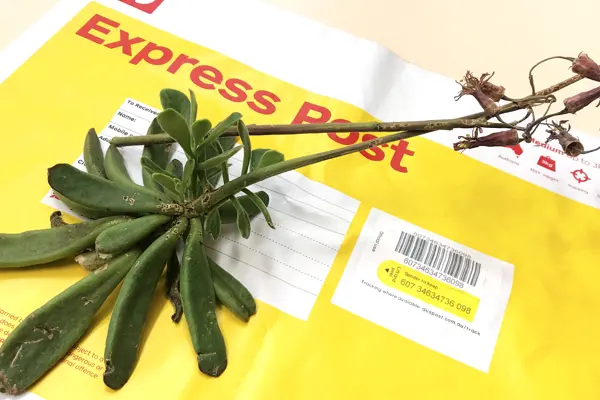
Submitting material for identification
Our ability to provide identifications depends on the quality of the plant material and associated information we receive. Properly collected and prepared specimens are essential and are more likely to result in an accurate identification.
Please do not send in material without first securing agreement from our Identifications Botanist. Doing so may result in the loss or spoilage of your specimens. You can contact the Identifications Botanist on (03) 9252 2315 to establish their availability, and to confirm any case specific requirements beyond those indicated below. This number may be unattended when the team is on leave.
Specimens requiring identification can either be left in an addressed envelope at our main reception in the Visitor Centre, or sent by mail. All submissions should be addressed to:
Plant Identifications & Information Service
National Herbarium of Victoria
Locked Bag 2000
South Yarra 3141.
Specimens should be accompanied by a typed cover letter clearly indicating what you require.
Please provide a postal address for correspondence and invoicing, as well as a phone number or email address for easy communication. Please state clearly to whom the invoice is to be made out.
Large batches of specimens (ten or more) will not be accepted without prior arrangement made with the Identification Botanist.
Specimen preparation
Specimens should be as complete as possible. Features such as flowers and fruits are very important as it is not often possible to identify plants from leaves alone. Images of the living plant are useful, but should not be submitted without a specimen. We do not provide identifications based on images alone.
- Each specimen must have a separate, securely attached label/written description
Please include tentative ID if available, along with location details (name, coordinates), and a description of the habitat from which the material was collected. Specimens without associated information will be de-prioritised or returned to sender. - Specimens can be sent either fresh or dried
- If sending fresh material
Place the specimen inside a sealed plastic bag, and place the bag inside a padded envelope, box or mailing tube. If the plant requires moisture (e.g. aquatics or delicate herbs) add a moistened tissue or paper towel to the plastic bag, but do not saturate the specimen.
Ensure that the specimens are placed in the post early in the working week as they can deteriorate beyond recognition if delayed. - If sending dried material
Ensure that the specimen is dried under pressure in a plant press and not left lying around to dry. Specimens should not be mounted in any way, e.g. do not use adhesive tape.
We reserve the right to reject or discard poor specimens or specimens submitted with insufficient information. We also reserve the right to retain all specimens of scientific interest as donations for the Herbarium collection. Specimens not required as donations will be discarded. We do not return specimens. If you require a specimen of your identified plant, please retain a duplicate from the outset (ensure that the sample that you send us is from the same plant that you retain).
Please note that plants and fungi must not be removed from any parks, reserves or public land without a permit to do so issued by state government.
